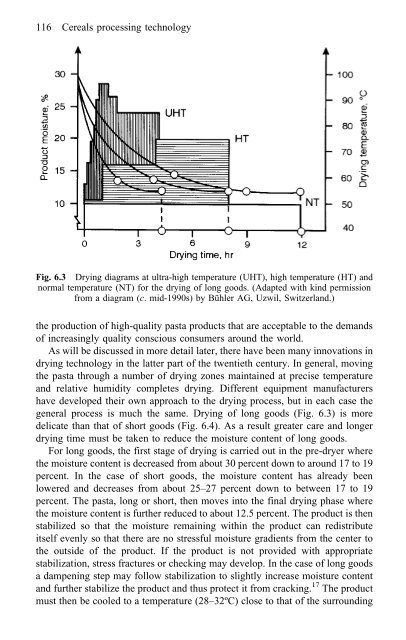Cereals processing technology
Cereals processing technology
Cereals processing technology
Create successful ePaper yourself
Turn your PDF publications into a flip-book with our unique Google optimized e-Paper software.
116 <strong>Cereals</strong> <strong>processing</strong> <strong>technology</strong><br />
Fig. 6.3 Drying diagrams at ultra-high temperature (UHT), high temperature (HT) and<br />
normal temperature (NT) for the drying of long goods. (Adapted with kind permission<br />
from a diagram (c. mid-1990s) by Bühler AG, Uzwil, Switzerland.)<br />
the production of high-quality pasta products that are acceptable to the demands<br />
of increasingly quality conscious consumers around the world.<br />
As will be discussed in more detail later, there have been many innovations in<br />
drying <strong>technology</strong> in the latter part of the twentieth century. In general, moving<br />
the pasta through a number of drying zones maintained at precise temperature<br />
and relative humidity completes drying. Different equipment manufacturers<br />
have developed their own approach to the drying process, but in each case the<br />
general process is much the same. Drying of long goods (Fig. 6.3) is more<br />
delicate than that of short goods (Fig. 6.4). As a result greater care and longer<br />
drying time must be taken to reduce the moisture content of long goods.<br />
For long goods, the first stage of drying is carried out in the pre-dryer where<br />
the moisture content is decreased from about 30 percent down to around 17 to 19<br />
percent. In the case of short goods, the moisture content has already been<br />
lowered and decreases from about 25–27 percent down to between 17 to 19<br />
percent. The pasta, long or short, then moves into the final drying phase where<br />
the moisture content is further reduced to about 12.5 percent. The product is then<br />
stabilized so that the moisture remaining within the product can redistribute<br />
itself evenly so that there are no stressful moisture gradients from the center to<br />
the outside of the product. If the product is not provided with appropriate<br />
stabilization, stress fractures or checking may develop. In the case of long goods<br />
a dampening step may follow stabilization to slightly increase moisture content<br />
and further stabilize the product and thus protect it from cracking. 17 The product<br />
must then be cooled to a temperature (28–32ºC) close to that of the surrounding



